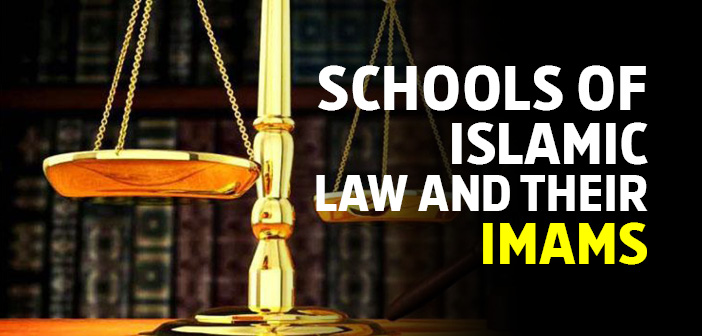
The Holy Qur’an, Tradition and Ijtihad are the three main sources of Islamic law which govern and regulate all aspects of a Muslim’s public and private life. These laws relate to religious worship, prohibitions, and all contracts and obligations that arise in social life such as inheritance, marriage, divorce, punishments, conduct of war and the administration of the state.
The science of these religious laws is called Fiqah and the expert in this field such as a jurist is called a faqih (plural: fuqaha).
We read that Ijtihad, or the exercise of judgement, is a valid source of Islamic laws in areas where the Holy Qur’an and the Traditions are not explicit. But the exercise of this independent judgement can only be left in the hands of proper scholars of the Holy Qur’an and the Tradition.
The vast majority of Muslims give this right of independent reasoning to only four ancient Muslim theologians and jurists who lived in the first three centuries of Islam. These four fuqaha are:
SUNNI SCHOOLS:
Imam Abu Hanifa of Kufa
Imam Malik bin Anas of Medinah
Imam Muhammad al-Shafi of Medinah
Imam Ahmad bin Hanbal of Baghdad
Although a number of other jurists also became popular during their times, only the above four are now recognised by the vast majority of Sunni Muslims. These four great jurists and theologians tried to systemise the Islamic law into a comprehensive rational system which covered all possible legal situations. The four prominent schools of Islamic law are named after their founders and are called the Hanafiyya, the Malikiyya, the Shafiyya, and the Hanbaliyya schools of religious law.
Most Muslims regard these four schools as equally valid interpretations of the religious law of Islam. These schools are in good agreement on all essential aspects of the religion of Islam. They all acknowledge the authority of the Holy Qur’an and the Traditions as the ultimate source of the Islamic law. Only in areas and situations where these two sources are silent, do the four schools use their independent reasoning in which they may differ with each other.
THE HANAFI SCHOOL:
The Hanafi School is the oldest surviving school of Islamic law, and the one with the largest following.
It originated in Kufa, present day Iraq, but its influence spread to both the Mughal and Ottoman empires and can now be found from Turkey to Central Asia, the Balkans, Iraq, Afghanistan, Pakistan, India, Bangladesh, and as far as Western Europe and North America.
The school’s founder, Abu Hanifa, was a trader as a young man. However, it seems he was not well suited to this career – he once demanded to pay five times the asking price from a woman selling silk at the market.
In 763 CE he was imprisoned for refusing to collaborate with a judiciary he considered corrupt. He died in prison four years later.
As well as using the Quran and the Prophet’s (pbuh) life as sources of guidance, this group also relied heavily on using logical arguments to find answers to social problems that also fitted in with their understanding of Islam.
THE SHAFI’I SCHOOL:
The Shafi’i School also has a wide influence in Egypt, Indonesia, the Philippines, Brunei, Singapore, Thailand, Sri Lanka and the Maldives.
This school of thought is named after Muhammad ibn Idris al-Shafi’i, a precocious student, who is described by historians as the master architect of Islamic law.
Perhaps his greatest achievement, with the aid of his peers, was to lay down the roots of a common framework for all schools of Islamic thought to follow when producing legal judgements on issues of faith and how it should be practised.
THE MALIKI SCHOOL
This school is named after Imam Anas bin Malik, 715 CE, who, to support his studies, sold the ceiling beams of his home to buy the necessary books.
He was an unwavering defender of personal freedom, famously issuing a fatwa that stated that no person should be forced to pledge allegiance to the ruling government in Medina, and was heavily flogged for doing so (although the authorities later apologised for their actions).
The Maliki School has its main following in Egypt, as well as having smaller groups of followers in Algeria, Tunis, Morocco, Mauritania, Libya, Kuwait, Bahrain, Dubai and Abu Dhabi, although it originated in Saudi Arabia in the city of Medina. When the Maliki School was formed the word Sunnah did not yet mean the ‘traditions’ or ‘practice’ of the Prophet (pbuh) specifically but also referred to the actions of the people of Medina at the time.
THE HANBALI SCHOOL:
The Hanbali School was developed in Baghdad, although today the followers of the school are concentrated mainly in Saudi Arabia and the United Arab Emirates.
The founder of the school, Imam Ahmad Ibn Hanbal, was taught by Muhammad ibn Idris al-Shafi’i, the founder of the Shafi’i School. There is therefore a direct link between the Shafi’i and the Hanbali school.
The Hanbali school derives its rulings almost solely from the Quran and Sunnah, which proves to be popular with groups of people wishing to return to a ‘purer’ Islam (the Wahabi movement, for instance, emerged out of the Hanbali school). Other influential figures in the school were al-Kiraqi (d. 946), Ibn Qudama (d. 1223).[3], Ibn Taymiyya (d. 1328) and al-Qayyim al-Jawziyya (d. 1350).
Post Disclaimer | Support Us
Support Us
The sailanmuslim.com web site entirely supported by individual donors and well wishers. If you regularly visit this site and wish to show your appreciation, or if you wish to see further development of sailanmuslim.com, please donate us
IMPORTANT : All content hosted on sailanmuslim.com is solely for non-commercial purposes and with the permission of original copyright holders. Any other use of the hosted content, such as for financial gain, requires express approval from the copyright owners.
 Sri lanka Muslims Web Portal Sri Lanka Muslims News Center
Sri lanka Muslims Web Portal Sri Lanka Muslims News Center
 Donate
Donate

